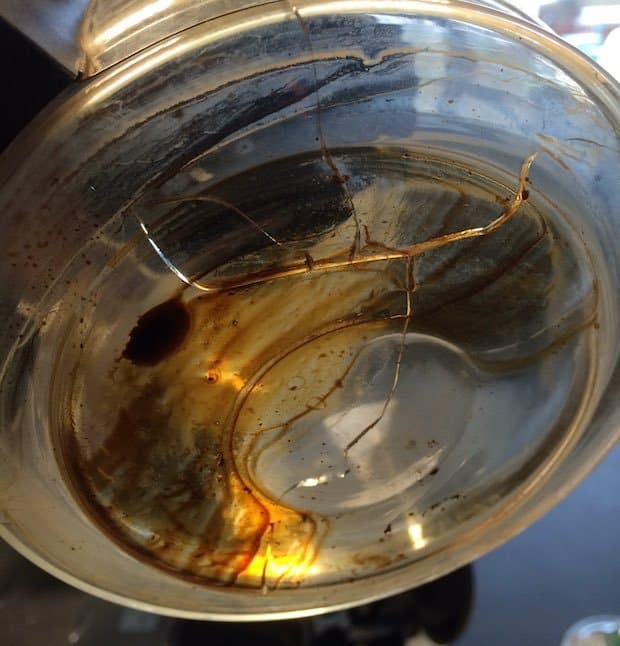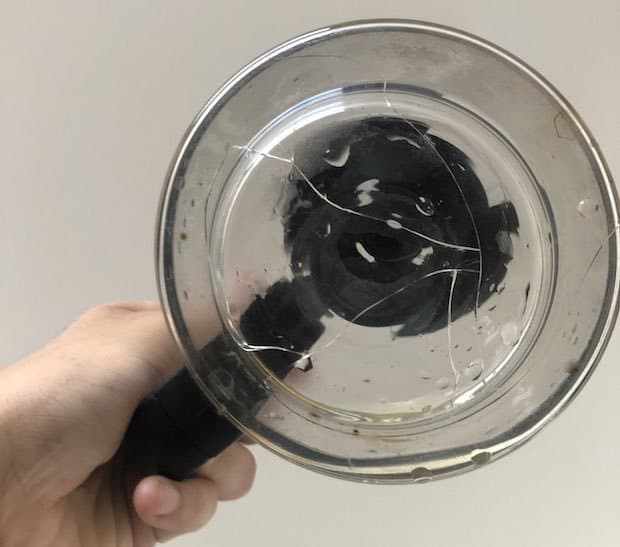Just so you know, as an Amazon Associate we earn from qualifying purchases made via bold red links, buttons or images.
Last Updated on September 1, 2024
Many non-coffee drinkers don’t realize how difficult it can be for coffee aficionados to find a coffee pot they love that consistently brews delicious joe. Once you find one, you never want to let it go.
That’s why it’s devastating if your glass coffee pot cracks. Very often, coffee lovers avoid more durable materials such as plastic because it negatively impacts the flavor of the coffee.
Let’s look at not only how to fix a cracked coffee pot, but how to prevent cracks in the first place.
What causes coffee pots to crack?
Besides obvious accidents, there are other things that cause coffee pots to crack. One of the most common is dramatic and sudden changes in temperature. If your coffee pot was just full of hot liquid, don’t try to rinse it with cold water or toss ice cubes into it. It could crack.
In addition, friction and force over time (often from normal wear and tear) can cause glass to crack. Unfortunately, the type of glass that composes most coffee pots is not designed to last forever.

Dishwashers are also notorious crime scenes when it comes to cracked coffee pots, whether it’s the temperature of the water or the force at which the washing cycle runs. Always hand wash your coffee pot.
How to fix a cracked coffee pot
OK, the coffee pot is already cracked, so now what? You can try one of a number of methods of fixing it.
Fixing a cracked coffee pot with glue
The first is to try to seal the crack with glue.
Loctite Glass Glue is made specifically for gluing glass pieces back together.
You are going to run into two main issues with this method. First, the glue might not be effective in stopping the crack. Certainly, you should use superglue, gorilla glue, or another ultra-strong type of glue. But even then, coffee may still be able to seep through in tiny places that the glue is not able to seal.
To test it, fill the pot with cool water, dry the outside completely using a towel, and then set the pot on a paper towel. If the paper towel stays dry, the glue has probably done the trick.
Even if you do manage to completely seal the crack using glue, the glue might melt when hot coffee is added to the pot. If that happens, the best-case scenario is that the coffee starts leaking again. The worst-case scenario is that the melting glue seeps into your coffee itself, destroying the taste or, even worse, becoming dangerous.
To avoid this second pitfall, be sure to use heatproof, non-melting glue. And it’s probably a good idea to use a food-safe brand such as Loctite Glass Glue.
Fixing a cracked coffee pot with sealant
Instead of glue, you can use another type of sealant around the crack to try to repair the coffee pot. You can buy silicone sealant or other types. Visit a home supply store or hardware store for these items. Sometimes they are in the form of a simple patch that you can stick onto the pot.
Silco RTV 4500 sealant is safe for food contact up to 350 F, which should be plenty.
The same precautions and caveats are going to stand with sealant as with regular glue: It might not completely seal the crack, and it might end up melting and leaking into the coffee itself.
Buy something to go around the outside
Another option to salvage the cracked coffee pot is to buy another material to go around the outside of the pot and keep the coffee in, almost like a jacket. This is going to be more effective if you’ve cracked a carafe or a French press rather than a traditional pot for a coffee machine.
Replace the pot
In the event that you cracked the coffee pot to a traditional coffee maker, the method above probably won’t work. However, you can actually replace just the pot and keep the rest of the machine. Most companies make replacement pots that you can buy online on their websites, Amazon, or other big box stores.

This is also an environmentally friendly option because you reduce waste by not throwing out the entire contraption. If your pot is glass, be sure to recycle it.
Get a new machine
If all else fails, you may need to get a new coffee pot entirely. Check to see if the one that you currently own and love is still being manufactured. There’s a good chance that you don’t have to deal with change at all.
If not, and you need to buy an entirely new model, try to look for something more durable. As we said above, plastic isn’t a great option because it can negatively impact the taste.
Try looking for more durable glass or stainless steel. Many people swear by stainless steel.
Preventing broken coffee pots
Let’s run through a few tips to avoid cracking your coffee pot in the first place:
- Wash in lukewarm water with mild soap
- Don’t put it in the dishwasher
- Allow the coffee pot to cool completely before washing it
Store the pot itself in a cabinet or away from high-traffic areas where it might get bumped or banged.



